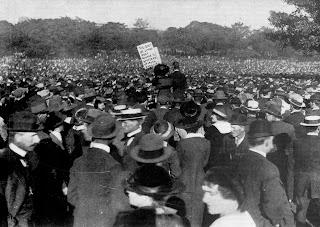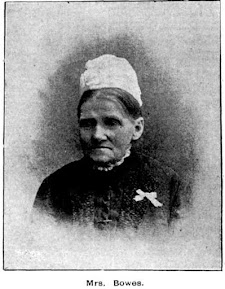Working Class Tragedy
Today marks the beginning of 105th anniversary of the Great Strike of 1917 that had a tragic outcome for a resident of Rookwood.
MERVYN FLANAGAN
Mervyn was the son of John J Flanagan, a carter, and Susan Webster, a widow, who came to the union with five young children. Mervyn was their first child born in 1885 and was followed by four more children; a large working class family who resided in the working class suburb of Waterloo.
Like his father, Mervyn became a carter (horse-drawn cart driver), married Beatrice at the age of 20 in 1905 and watched his first born son die a few months after their marriage. He and Beatrice went on to have 3 more boys.
Mervyn was a member of the Trolley, Draymen and Carter's Union and was one of the nearly 70,000 people who took to the streets to protest changes to how the productivity of rail and tram workers was to be monitored. It began in NSW and spread to other States over six weeks from 2nd August to 8th September 1917.
The NSW Department of Railways and Tramways introduced a new labour costing system that used cards to record the tasks each worker was assigned and the time it took them to complete those tasks. Concern was raised over the right to view or modify their card and the potential use of the card to identify, and presumably to dismiss, "slow" or "inefficient" workers. The strike began at the Randwick Workshops and the Eveleigh Carriage Shops at Redfern with workers walking off the job in protest. Their cause was taken up throughout the NSW railway system and eventually spread to other industries.
At the time real wages in Australia had fallen by approximately 30% between 1914 and 1919. Strike action had commenced in 1916 and this, with the combined anger at the attempt to introduce conscription combined with the disaffection of Irish-Australians, provided the powder keg of class tension in which the strike exploded.
On 2nd August the strike began with rank and file walkouts and later made official with further industries walking out on 6th August. The strike spread to the coal mines in NSW, the waterfront and the seaman. Groups of workers continued to join the strike up to September causing a domino effect throughout industry.
The strike was accompanied by scenes of mass protest with daily demonstrations in Sydney and Melbourne. In Sydney, the daily rallies peaked every Sunday with crowds up to 150,000.
Saturday August 1917 Demonstration - Dictionary of Sydney with thanks
The Government at both State and Federal level responded by organising strikebreaking on a mass scale. These strikebreakers were known as "volunteers" and consisted of university students with masters from private schools also prominent. These "volunteers" enabled a skeleton service at least on the railways to operate.
Crowd scene - phansw with thanks
It all came to a head at an altercation on 30 August 1917 on Bridge Road Camperdown where Mervyn Flanagan was shot in the chest by Richard Wearne, a Stock and Station Agent brought in as a strike breaker from the town of Bingara in the north of NSW. Mervyn died on the way to the nearby Royal Prince Alfted Hospital.
The Sydney Morning Herald at the time reported a group of striking carters including Flanagan assaulted Wearne after accusing him of being a "scab" - a claim Flanagan's brother James denied.
Wearne claimed that he was driving a lorry along Bridge Road when he was attacked and promptly fired off two shots, one of which hit a striker, Henry Williams, in the leg. He stated that he was further attacked from behind and after a further struggle shot his assailant, Mervyn Flanagan.
What followed next made Mervyn's death a watershed moment for the Labour movement. Wearne, who had political connections, was acquitted of all charges. The Jury found there was no cause to answer, being led by an Acting Coroner from Bingara, and the Magistrate dismissed the case. It might be noted that Richard's brother, Walter Ernest, had for a number of years been a member of the NSW Parliament.
The Coroners report states that Flanagan died from the "effects of a bullet wound in the chest, fired upon him by Reginald James Wearne, in his own defence."
Even though Wearne was acquitted, James Flanagan and Henry Williams were jailed for three months.
Mervyn's death provoked an outpouring of grief - in a time of profound grief. His casket was carried in a horse-drawn hearse as part of a 1.6 km funeral procession through central Sydney from the Trades Hall to the the Mortuary Station for rail transport to Rookwood.
Cortage at the funeral of Mervyn Flanagan - twunsw with thanks
On 9th September 1917 the Defence Committee declared the strike over in terms which amounted to a complete surrender. The decision was denounced as a sellout in a series of mass meetings but slowly the masses returned to work but it lingered on in some industries, the Melbourne waterfront for one, until December.
The defeat was a heavy blow for the Labour movement and a major factor for a second conscription referendum in December 1917. The referendum was defeated and the Unions recovered their strength within a few years.
Mervyn died for his cause and will not be forgotten. There have been calls to release further documents relating to the incident causing his death and investigation into the policy of issuing weapons to strike breakers.
Beatrice, his widow, the mother of three young boys, remarried to Stephen Moore in 1920. It appears she moved away from Sydney some time after to Nowra where she died in 1973.
Mervyn Flanagan's Headstone - Find A Grave - with thanks
Mervyn lies in the newer Catholic area of the Cemetery just south of Haslem Drive with his half brother Ernest who predeceased him. Mervyn's father and grandfather also lie in the cemetery, in the older Catholic area.
On the 26th August 2018 an historical plaque was placed at the site where Mervyn Flanagan fell, funded by TWUNSW.
There are many references to the Strike of 1917 which can be located by a simple Google search, a short film is able to be viewed provided by the National Film and Sound Archive (NFSA).
Please feel free to comment below or at the group facebook page which you can find by searching rookwoodcemeterydiscoveries.blogspot.com







Another very interesting post…🍂
ReplyDelete